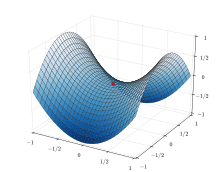Minimax theorem
In the mathematical area of game theory and of convex optimization, a minimax theorem is a theorem that claims that
under certain conditions on the sets and and on the function .[1] It is always true that the left-hand side is at most the right-hand side (max–min inequality) but equality only holds under certain conditions identified by minimax theorems. The first theorem in this sense is von Neumann's minimax theorem about two-player zero-sum games published in 1928,[2] which is considered the starting point of game theory. Von Neumann is quoted as saying "As far as I can see, there could be no theory of games ... without that theorem ... I thought there was nothing worth publishing until the Minimax Theorem was proved".[3] Since then, several generalizations and alternative versions of von Neumann's original theorem have appeared in the literature.[4][5]
Bilinear functions and zero-sum games
Von Neumann's original theorem[2] was motivated by game theory and applies to the case where
- and are standard simplexes: and , and
- is a linear function in both of its arguments (that is, is bilinear) and therefore can be written for a finite matrix , or equivalently as .
Under these assumptions, von Neumann proved that
In the context of two-player zero-sum games, the sets and correspond to the strategy sets of the first and second player, respectively, which consist of lotteries over their actions (so-called mixed strategies), and their payoffs are defined by the payoff matrix . The function encodes the expected value of the payoff to the first player when the first player plays the strategy and the second player plays the strategy .
Concave-convex functions

Von Neumann's minimax theorem can be generalized to domains that are compact and convex, and to functions that are concave in their first argument and convex in their second argument (known as concave-convex functions). Formally, let and be compact convex sets. If is a continuous function that is concave-convex, i.e.
Then we have that
Sion's minimax theorem
Sion's minimax theorem is a generalization of von Neumann's minimax theorem due to Maurice Sion,[6] relaxing the requirement that It states:[6][7]
Let be a convex subset of a linear topological space and let be a compact convex subset of a linear topological space. If is a real-valued function on with
- upper semicontinuous and quasi-concave on , for every fixed , and
- lower semicontinuous and quasi-convex on , for every fixed .
Then we have that
See also
- Parthasarathy's theorem – a generalization of Von Neumann's minimax theorem
- Dual linear program can be used to prove the minimax theorem for zero-sum games.
- Yao's principle – an application of the minimax theorem to computational complexity
References
- ^ Simons, Stephen (1995), Du, Ding-Zhu; Pardalos, Panos M. (eds.), "Minimax Theorems and Their Proofs", Minimax and Applications, Boston, MA: Springer US, pp. 1–23, doi:10.1007/978-1-4613-3557-3_1, ISBN 978-1-4613-3557-3, retrieved 2024-10-27
- ^ a b Von Neumann, J. (1928). "Zur Theorie der Gesellschaftsspiele". Math. Ann. 100: 295–320. doi:10.1007/BF01448847. S2CID 122961988.
- ^ John L Casti (1996). Five golden rules: great theories of 20th-century mathematics – and why they matter. New York: Wiley-Interscience. p. 19. ISBN 978-0-471-00261-1.
- ^ Du, Ding-Zhu; Pardalos, Panos M., eds. (1995). Minimax and Applications. Boston, MA: Springer US. ISBN 9781461335573.
- ^ Brandt, Felix; Brill, Markus; Suksompong, Warut (2016). "An ordinal minimax theorem". Games and Economic Behavior. 95: 107–112. arXiv:1412.4198. doi:10.1016/j.geb.2015.12.010. S2CID 360407.
- ^ a b Sion, Maurice (1958). "On general minimax theorems". Pacific Journal of Mathematics. 8 (1): 171–176. doi:10.2140/pjm.1958.8.171. MR 0097026. Zbl 0081.11502.
- ^ Komiya, Hidetoshi (1988). "Elementary proof for Sion's minimax theorem". Kodai Mathematical Journal. 11 (1): 5–7. doi:10.2996/kmj/1138038812. MR 0930413. Zbl 0646.49004.





![{\textstyle X=\{(x_{1},\dots ,x_{n})\in [0,1]^{n}:\sum _{i=1}^{n}x_{i}=1\}}](https://wikimedia.org/api/rest_v1/media/math/render/svg/cb749fa56cc2d6d273ebce53dc103d1969d6e722)
![{\textstyle Y=\{(y_{1},\dots ,y_{m})\in [0,1]^{m}:\sum _{j=1}^{m}y_{j}=1\}}](https://wikimedia.org/api/rest_v1/media/math/render/svg/30e67b4e838f2cac633d4ed0e7493590ce15ed7d)



















